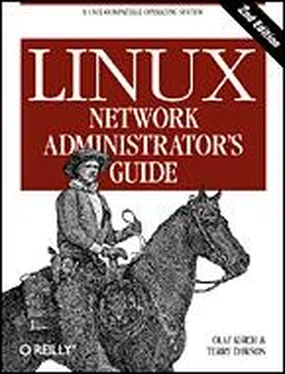Another very important aspect of system administration in a network environment is protecting your system and users from intruders. Carelessly managed systems offer malicious people many targets. Attacks range from password guessing to Ethernet snooping, and the damage caused may range from faked mail messages to data loss or violation of your users' privacy. We will mention some particular problems when discussing the context in which they may occur and some common defenses against them.
This section will discuss a few examples and basic techniques for dealing with system security. Of course, the topics covered cannot treat all security issues you may be faced with in detail; they merely serve to illustrate the problems that may arise. Therefore, reading a good book on security is an absolute must, especially in a networked system.
System security starts with good system administration. This includes checking the ownership and permissions of all vital files and directories and monitoring use of privileged accounts. The COPS program, for instance, will check your file system and common configuration files for unusual permissions or other anomalies. It is also wise to use a password suite that enforces certain rules on the users' passwords that make them hard to guess. The shadow password suite, for instance, requires a password to have at least five letters and to contain both upper- and lowercase numbers, as well as non-alphabetic characters.
When making a service accessible to the network, make sure to give it "least privilege"; don't permit it to do things that aren't required for it to work as designed. For example, you should make programs setuid to root or some other privileged account only when necessary. Also, if you want to use a service for only a very limited application, don't hesitate to configure it as restrictively as your special application allows. For instance, if you want to allow diskless hosts to boot from your machine, you must provide Trivial File Transfer Protocol (TFTP) so that they can download basic configuration files from the /boot directory. However, when used unrestrictively, TFTP allows users anywhere in the world to download any world-readable file from your system. If this is not what you want, restrict TFTP service to the /boot directory. [10] We will come back to this topic in Chapter 12, Important Network Features.
You might also want to restrict certain services to users from certain hosts, say from your local network. In Chapter 12, we introduce tcpd, which does this for a variety of network applications. More sophisticated methods of restricting access to particular hosts or services will be explored later in Chapter 9.
Another important point is to avoid "dangerous" software. Of course, any software you use can be dangerous because software may have bugs that clever people might exploit to gain access to your system. Things like this happen, and there's no complete protection against it. This problem affects free software and commercial products alike. [11] There have been commercial Unix systems (that you have to pay lots of money for) that came with a setuid-root shell script, which allowed users to gain root privilege using a simple standard trick.
However, programs that require special privilege are inherently more dangerous than others, because any loophole can have drastic consequences. [12] In 1988, the RTM worm brought much of the Internet to a grinding halt, partly by exploiting a gaping hole in some programs including the sendmail program. This hole has long since been fixed.
If you install a setuid program for network purposes, be doubly careful to check the documentation so that you don't create a security breach by accident.
Another source of concern should be programs that enable login or command execution with limited authentication. The rlogin, rsh, and rexec commands are all very useful, but offer very limited authentication of the calling party. Authentication is based on trust of the calling host name obtained from a name server (we'll talk about these later), which can be faked. Today it should be standard practice to disable the r commands completely and replace them with the ssh suite of tools. The ssh tools use a much more reliable authentication method and provide other services, such as encryption and compression, as well.
You can never rule out the possibility that your precautions might fail, regardless of how careful you have been. You should therefore make sure you detect intruders early. Checking the system log files is a good starting point, but the intruder is probably clever enough to anticipate this action and will delete any obvious traces he or she left. However, there are tools like tripwire, written by Gene Kim and Gene Spafford, that allow you to check vital system files to see if their contents or permissions have been changed. tripwire computes various strong checksums over these files and stores them in a database. During subsequent runs, the checksums are recomputed and compared to the stored ones to detect any modifications.
Chapter 2. Issues of TCP/IP Networking
In this chapter we turn to the configuration decisions you'll need to make when connecting your Linux machine to a TCP/IP network, including dealing with IP addresses, hostnames, and routing issues. This chapter gives you the background you need in order to understand what your setup requires, while the next chapters cover the tools you will use.
To learn more about TCP/IP and the reasons behind it, refer to the three-volume set Internetworking with TCP/IP , by Douglas R. Comer (Prentice Hall). For a more detailed guide to managing a TCP/IP network, see TCP/IP Network Administration by Craig Hunt (O'Reilly).
To hide the diversity of equipment that may be used in a networking environment, TCP/IP defines an abstract interface through which the hardware is accessed. This interface offers a set of operations that is the same for all types of hardware and basically deals with sending and receiving packets.
For each peripheral networking device, a corresponding interface has to be present in the kernel. For example, Ethernet interfaces in Linux are called by such names as eth0 and eth1 ; PPP (discussed in Chapter 8, The Point-to-Point Protocol) interfaces are named ppp0 and ppp1 ; and FDDI interfaces are given names like fddi0 and fddi1 . These interface names are used for configuration purposes when you want to specify a particular physical device in a configuration command, and they have no meaning beyond this use.
Before being used by TCP/IP networking, an interface must be assigned an IP address that serves as its identification when communicating with the rest of the world. This address is different from the interface name mentioned previously; if you compare an interface to a door, the address is like the nameplate pinned on it.
Other device parameters may be set, like the maximum size of datagrams that can be processed by a particular piece of hardware, which is referred to as Maximum Transfer Unit (MTU). Other attributes will be introduced later. Fortunately, most attributes have sensible defaults.
As mentioned in Chapter 1, Introduction to Networking, the IP networking protocol understands addresses as 32-bit numbers. Each machine must be assigned a number unique to the networking environment. [13] The version of the Internet Protocol most frequently used on the Internet is Version 4. A lot of effort has been expended in designing a replacement called IP Version 6. IPv6 uses a different addressing scheme and larger addresses. Linux has an implementation of IPv6, but it isn't ready to document it in this book yet. The Linux kernel support for IPv6 is good, but a large number of network applications need to be modified to support it as well. Stay tuned.
If you are running a local network that does not have TCP/IP traffic with other networks, you may assign these numbers according to your personal preferences. There are some IP address ranges that have been reserved for such private networks. These ranges are listed in Table 2.1. However, for sites on the Internet, numbers are assigned by a central authority, the Network Information Center (NIC). [14] Frequently, IP addresses will be assigned to you by the provider from whom you buy your IP connectivity. However, you may also apply to the NIC directly for an IP address for your network by sending email to hostmaster@internic.net, or by using the form at http://www.internic.net/.
Читать дальше



![Andrew Radford - Linguistics An Introduction [Second Edition]](/books/397851/andrew-radford-linguistics-an-introduction-second-thumb.webp)








